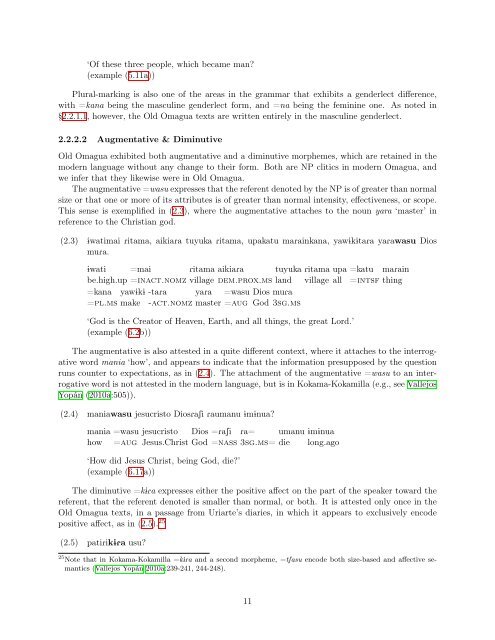draft manuscript - Linguistics - University of California, Berkeley
draft manuscript - Linguistics - University of California, Berkeley
draft manuscript - Linguistics - University of California, Berkeley
You also want an ePaper? Increase the reach of your titles
YUMPU automatically turns print PDFs into web optimized ePapers that Google loves.
‘Of these three people, which became man?<br />
(example (5.11a))<br />
Plural-marking is also one <strong>of</strong> the areas in the grammar that exhibits a genderlect difference,<br />
with =kana being the masculine genderlect form, and =na being the feminine one. As noted in<br />
§2.2.1.1, however, the Old Omagua texts are written entirely in the masculine genderlect.<br />
2.2.2.2 Augmentative & Diminutive<br />
Old Omagua exhibited both augmentative and a diminutive morphemes, which are retained in the<br />
modern language without any change to their form. Both are NP clitics in modern Omagua, and<br />
we infer that they likewise were in Old Omagua.<br />
The augmentative =wasu expresses that the referent denoted by the NP is <strong>of</strong> greater than normal<br />
size or that one or more <strong>of</strong> its attributes is <strong>of</strong> greater than normal intensity, effectiveness, or scope.<br />
This sense is exemplified in (2.3), where the augmentative attaches to the noun yara ‘master’ in<br />
reference to the Christian god.<br />
(2.3) 1watimai Ritama, aikiaRa tuyuka Ritama, upakatu maRainkana, yaw1k1taRa yaRawasu Dios<br />
muRa.<br />
1wati =mai Ritama aikiaRa tuyuka<br />
be.high.up =inact.nomz village dem.prox.ms land<br />
=kana yaw1k1 -taRa yaRa =wasu Dios muRa<br />
=pl.ms make -act.nomz master =aug God 3sg.ms<br />
Ritama<br />
village<br />
upa<br />
all<br />
‘God is the Creator <strong>of</strong> Heaven, Earth, and all things, the great Lord.’<br />
(example (6.2b))<br />
=katu maRain<br />
=intsf thing<br />
The augmentative is also attested in a quite different context, where it attaches to the interrogative<br />
word mania ‘how’, and appears to indicate that the information presupposed by the question<br />
runs counter to expectations, as in (2.4). The attachment <strong>of</strong> the augmentative =wasu to an interrogative<br />
word is not attested in the modern language, but is in Kokama-Kokamilla (e.g., see Vallejos<br />
Yopán (2010a:505)).<br />
(2.4) maniawasu jesucristo DiosRaSi Raumanu 1m1nua?<br />
mania<br />
how<br />
=wasu<br />
=aug<br />
jesucristo Dios =RaSi Ra= umanu 1m1nua<br />
Jesus.Christ God =nass 3sg.ms= die long.ago<br />
‘How did Jesus Christ, being God, die?’<br />
(example (6.17a))<br />
The diminutive =k1Ra expresses either the positive affect on the part <strong>of</strong> the speaker toward the<br />
referent, that the referent denoted is smaller than normal, or both. It is attested only once in the<br />
Old Omagua texts, in a passage from Uriarte’s diaries, in which it appears to exclusively encode<br />
positive affect, as in (2.5). 25<br />
(2.5) patiRik1Ra usu?<br />
25 Note that in Kokama-Kokamilla =k1Ra and a second morpheme, =tSasu encode both size-based and affective semantics<br />
(Vallejos Yopán 2010a:239-241, 244-248).<br />
11
















